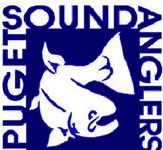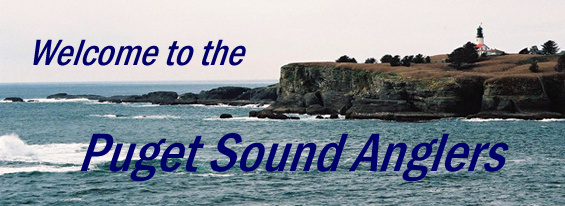|
May 2000 Speaker at South Sound chapter
Shrimping in Hood Canal
Bob
& Rick Caughie, owners of Hood Canal's Discount tackle
This month South Sound Chapter of Puget Sound Anglers had the pleasure of having Bob
& Rick Caughie, owners of Hood Canal's Discount tackle at 14640 E. Hiway 106 Belfair
WA as our speakers. Their phone is 360-275-2284, their e-mail is portcahe@hctc.com The subject
covered was shrimping in Hood Canal.
Bob has kept records of shrimping success/ failure for 15 years, and has made some
decisions as to pot configuration, set depth & bait that he passed on to us. It may be
a important factor for new scrimpers to thoroughly read the current fishing regulations as
to requirements.
POT
A round pot is preferable & seems to be a factor in attracting shrimp. He indicated
that the hexagonal would be his second choice, with the square one being the last. He did
note that with today's limits, that the square would probably still if in the right place,
limit you out. Entry cone angles also seem to make a difference.
It was this writers observance that their pots are very well made, well thought out,
& obviously made by shrimp fishermen. It would be very hard to describe them with
words, so I suggest you make a drive to Hood Canal & take a look yourself if you have
more than a passing interest in shrimping.
FLOAT & LINE Floats for shrimp are required to be yellow in color. Bob has
settled on a float design that consists of the float on a steel shaft threw it's center,
protruding about 3' above & 2' below the actual float. The float should be attached
with the square or non-rounded end down for more floatation. The top section can be used
to tie your identifying personal flag. It also has a small arm about 6" long
protruding out & up right at the top of the float for winding the line onto. The
bottom section also has a similar arm protruding out & down for the same purpose.
There is a ring in the bottom for attaching the line.
The line usually is 1/4" yellow nylon, with enough footage to be long enough for
your expected deepest water plus 100'. This line could be from 400' plus, depending where
you scrimp & the water conditions.
With this float system, you can wind all of your line onto these arms on the float
system. Then when you drop your pot, you do not need to throw all the excess line in the
water, just don't unwind any more than you need off the float unit, tie it off on the
bottom, and your excess line is attached to your float.
LINE WEIGHT
A snap on line weight is required by the WDFWL to keep the excess line from floating
& endangering other boaters props. It also serves a shock absorber for the pot. When
letting the pot down, do not just throw the whole thing in the water, as the line surely
will tangle on it's way down, & you will have lost the pot. Pay it out rapidly until
you feel it hit the bottom, then if in a calm day & not to much run-off add another 6
to 7 arm lengths (36'-42') before you attach the line weight of 12 oz. This 12 oz would be
a minimum for a calm day. For a windier & or higher run-off day add another 4 to 5 arm
length pulls before you put on the line weight of up to maybe a preferable 32 oz weight.
What this line weight does, again, it acts as a shock absorber between the float &
the pot. If the pot is jerked around by the float, which is moved by the waves, the shrimp
may be discouraged from entering the pot.
BAIT
Bait can be almost anything that has a fish smell to it. He however suggests when
you search for bait, that you try not to find anything that has shrimp in it, as shrimp
apparently are not cannibalistic.
The most commonly used bait is fish flavored cat food in cans. However any fish offcast
will work, as any oily fish, salmon roe, even fish fertilizer. His suggestion is to freeze
the bait, then take it out of the freezer & place it in a cooler so that it will only
be slightly thawed at the time the pot enters the water. His theory here is that the scent
trail should be released on the bottom & not wasted in the water column going down.
If using cans of cat food, there should be many large holes punched in the sides of the
cans for the scent to escape from. You can make a punch out of 3/4" steel or if any
of you happen to have the old can & bottle opener that pierces a triangle in the can,
this would probably work also.
DEPTH
In a new area to you, it may be best to set your pots out in different water depths,
depending on the number you have, starting at maybe 120' and out to 300'. In about an hour
pull them & then reset at the depth that you caught the most at on the first pull. Get
to know your area's bottom structure & when you find a good area, mark it by bearings
off shore locations or GPS.
PULLING
If you pull many pots, you will soon realize the benefits of a power pot puller. You
can buy commercially made ones either electric or gas driven, or homemade if you are handy
& inventive. When using a puller, there should be a pivoting boom mounted to the boat,
using a roller type block on the outer end. Pullers will have a low speed caspian spool
which you will wrap the line a couple of wraps on. By pulling & tightening up slightly
on the line over this spool, with the puller under power, the line will be pulled in.
The secret of pulling is to pull in a slow steady motion, which seems to use the force
of the water to hold the scrimp against the pot's bottom, otherwise the shrimp if given a
pull & stop motion, will sneak out thru the holes in the mesh.
Again Bob & Rick Caughie suggest you record your shrimping success, areas &
depths, even days & tides.
Copyright © 2004-2005 LeeRoy Wisner All Rights Reserved
Last Updated
06-09-2000
to
contact the author click here
|



